Hachee is a traditional beef and onion stew found in virtually every Dutch home. It’s a delicious comfort dish to enjoy during the cold winter months. The long, slow cooking time produce super tender meat and a rich sauce with wonderful depth of flavor. This authentic hachee recipe is one the whole family will love!
Serve this dish with mashed potatoes and braised red cabbage for a complete and traditional Dutch meal!
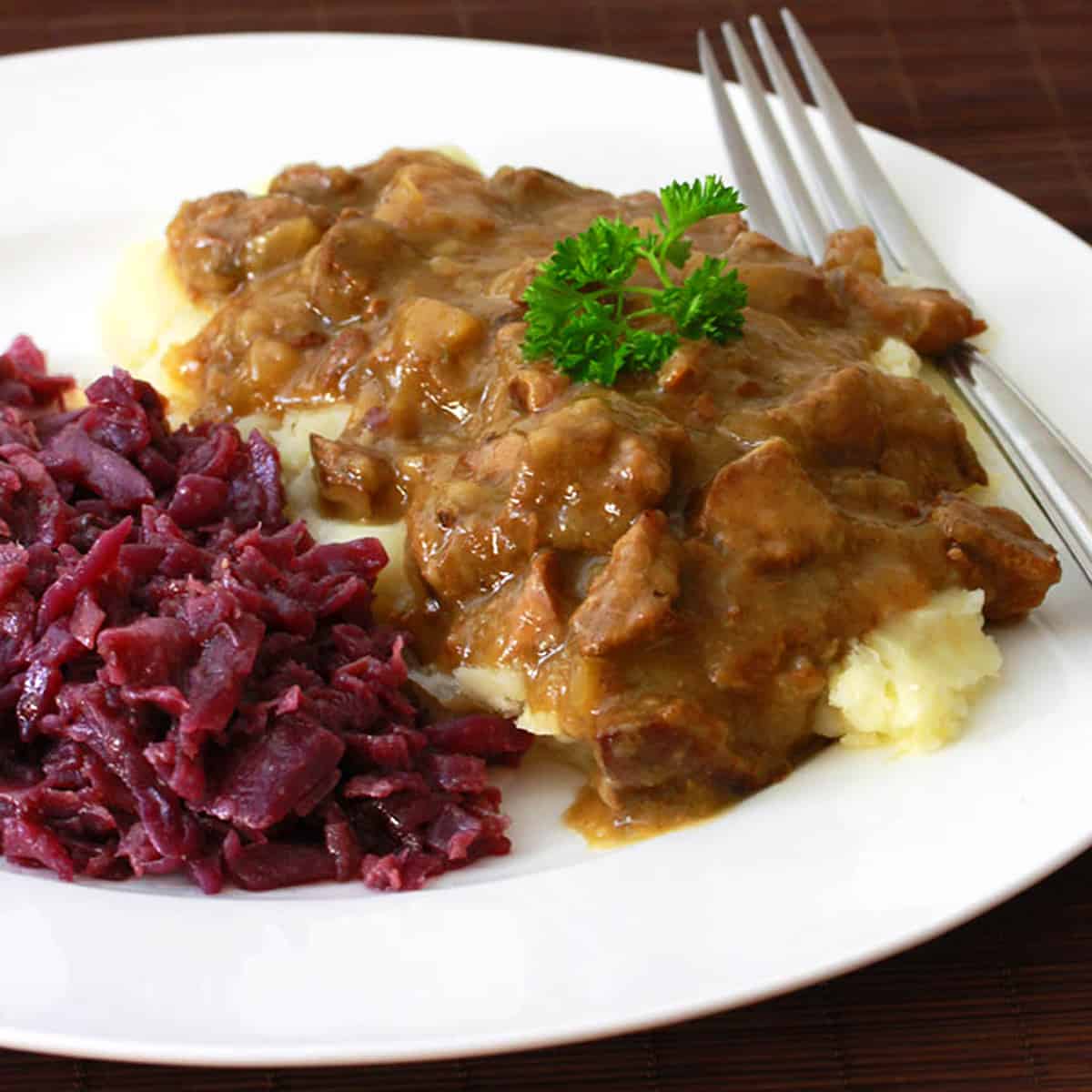
What is Hachee?
The word hachee has its origins in the French hacher, meaning “to chop” and Hachee is sometimes referred to as a “hash.” Hachee has been around since the middle ages and like many of the traditional dishes of Europe that we know and love today, it was originally a peasant dish, created as a means of using up leftover meat and vegetables. The vinegar was used to tenderize tough pieces of meat, much like the French used wine in Coq Au Vin). Less expensive vegetables likes onions were used in generous amounts. A long cooking process further ensured the meat would be tender. Hachee remains a popular and much-loved dish in the Netherlands. So much so that you can find it ready-made in grocery stores. But nothing beats homemade, and your patience in the long, slow cooking process will yield results that will make your taste buds swoon.
Traditional Seasonings in Hachee
The flavor profile of Hachee is significantly different from the traditional beef stews we know here in the U.S.. Hachee uses equal parts of beef and onion and the onions are caramelized. The featured flavors in this stew are cloves, juniper berries, black peppercorns, bay leaves and vinegar – all of which come together to provide a wonderful depth of flavor that is both rich and comforting. The flavor of Hachee shares similarities with German Sauerbraten.
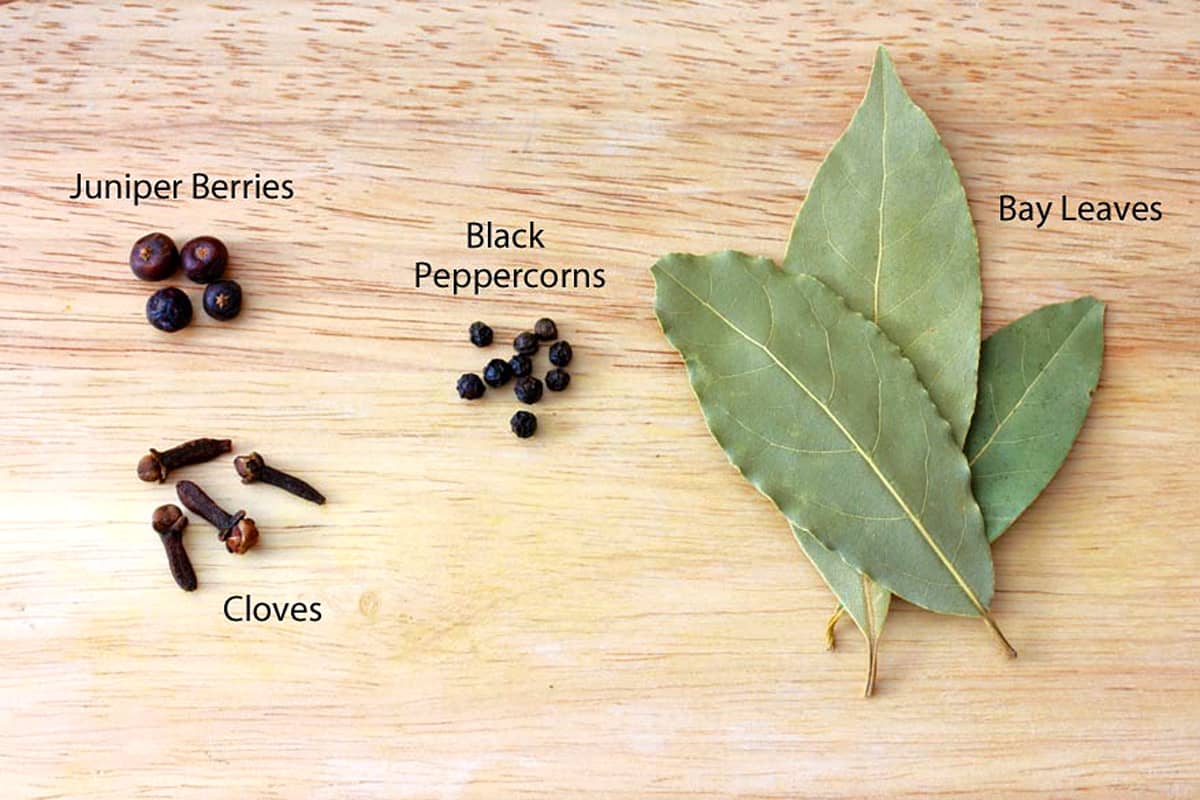
I first made this recipe over 10 years ago when my husband’s family came for a visit. My father-in-law had lived in the Netherlands for a while as a young adult and fell in love with the country, its people, and its food. Many of the dishes he enjoyed there over 40 years ago he hadn’t had since, and he has often mentioned longing to enjoy them again. So I wanted to surprise him with a traditional Dutch meal. I narrowed it down to three options: Boerenkool Stampot, Hutspot, and Hachee. I decided on Hachee. It’s a little more interesting, plus you can’t find the smoked Dutch sausages (rookworst) here that are traditionally eaten with the other two dishes. And it also gave me the excuse to finally make the braised red cabbage with it that many of my readers had been requesting – a side dish that is equally popular in Germany where it is known as Rotkohl.
As my father-in-law sat down to dinner he instantly recognized the dish. “This is the dish I had almost every night during my first two months in the Netherlands!” It was the first time he had had it in over 40 years and he savored every bit. We all did.
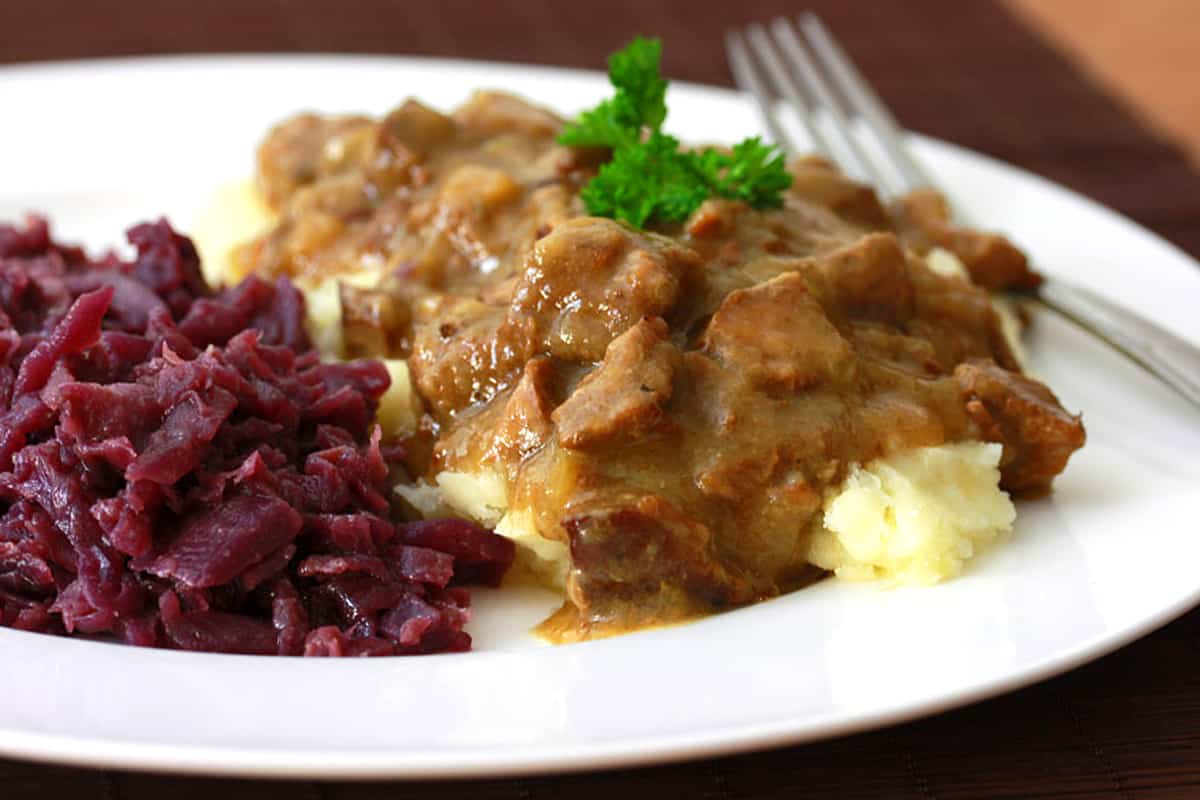
Hachee Recipe
Let’s get started!
Cube the beef and pat it dry with a paper towel – this will ensure that it browns well. Sprinkle with a little salt and pepper.
Brown the beef in a Dutch oven. Brown the cubes on all sides. Brown in batches so as not to overcrowd the beef – that will prevent it from browning properly. Remove the beef and set aside, leaving the burnt bits on the bottom of the pan – those will provide a lot of flavor to the stew.
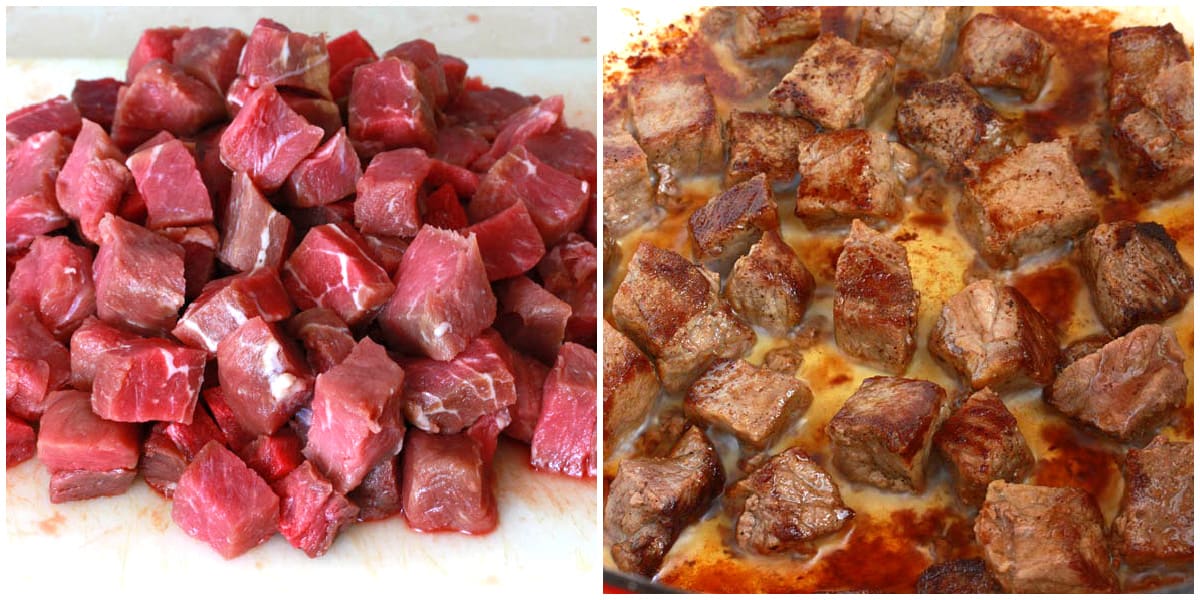
Add some more butter and caramelize the onions until golden brown. Add the flour and stir to combine.
Add the beef to the onions.
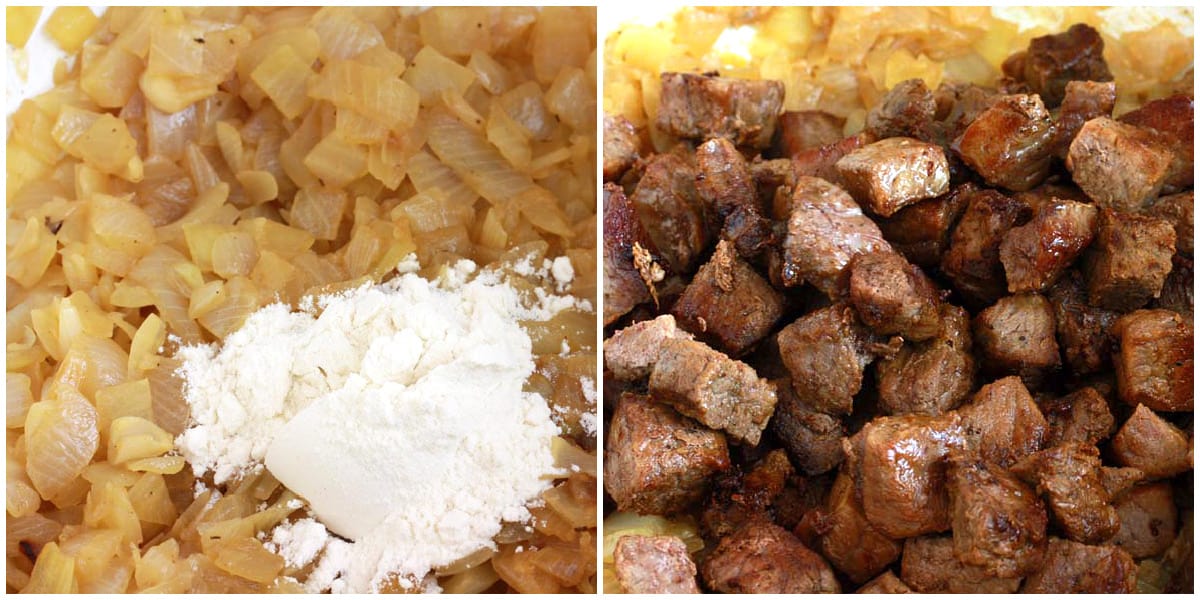
Add the beef broth and the seasonings. Bring to a boil, reduce the heat to low, cover and simmer for 2 1/2 hours. Uncover and simmer for another 30 minutes to help thicken the sauce. If it needs further thickening, make a slurry with equal parts of flour and water and stir it into the stew, stirring constantly to prevent lumping. Return to a simmer until the stew is thickened.
Add salt, pepper and more red wine vinegar to taste.
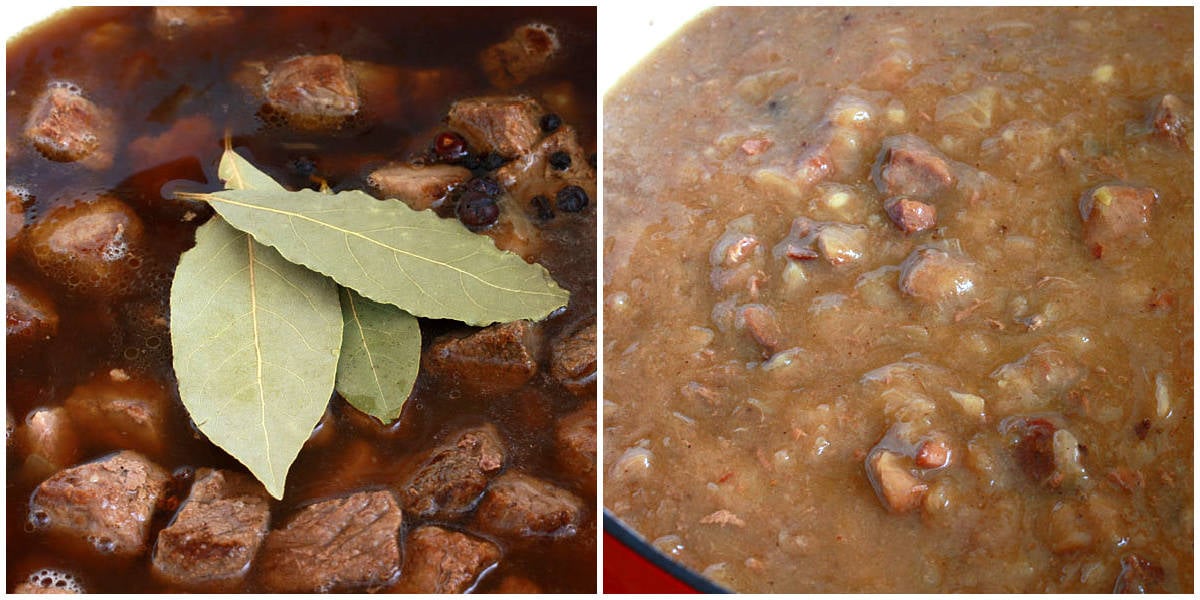
Hachee is traditionally served with aardappelen (potatoes) and rode kool met appeltjes, which is braised red cabbage with apples, also known as Rotkohl in German. A serving of applesauce is also common.
Eet smakelijk!
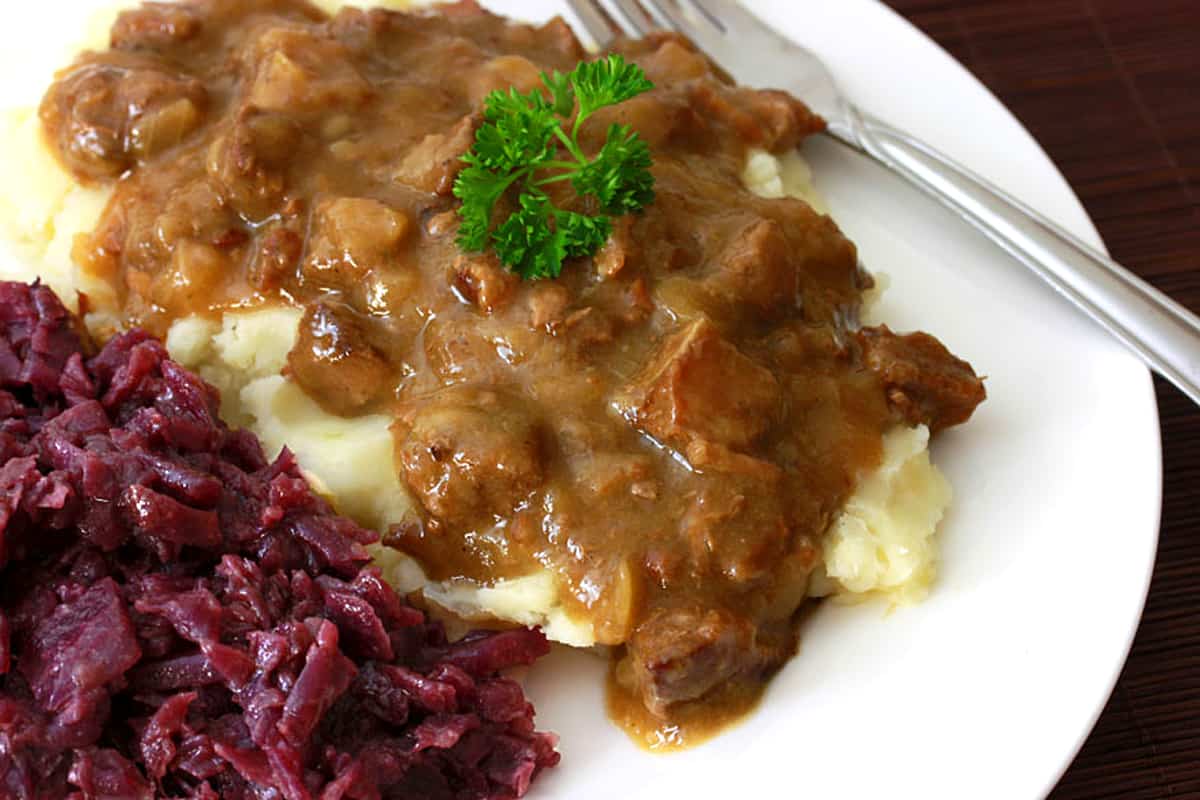
For more delicious beef stews from around the world be sure to try our:
- Swedish Kalops
- Hungarian Goulash
- Guinness Stew
- Pörkölt
- Beef Bourguignon
- Sega Wat
- Old Fashioned Beef Stew
- Domoda
- Szegedin Goulash
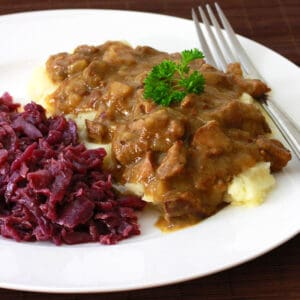
Hachee (Dutch Beef & Onion Stew)
Ingredients
- 2 pounds stewing beef (e.g. chuck) , cubed in 1/2 in. pieces, blotted dry with paper towel, lightly seasoned with salt and pepper
- 3 tablespoons butter
- 2 pounds yellow onions , about 4 large, finely chopped
- 1/4 cup all-purpose flour
- 4 cups good quality beef broth or stock
- 3 large bay leaves
- 4 cloves
- 4 juniper berries
- 10 black peppercorns
- 2 tablespoons red wine vinegar
- 3/4 teaspoon salt
- 1/4 teaspoon freshly ground black pepper
Instructions
- Melt the butter in a Dutch oven over medium-high heat. Brown the beef on all sides, working in batches so as not to overcrowd. Transfer to a plate and set aside. Leave the browned bits in the pan (important for flavor).Add the onions and some more butter if needed and cook until caramelized, about 25 minutes. Add the flour and stir until combined. Add the beef to the onions, stir to combine, and cover with the beef stock just until covered. Add the seasonings and red wine vinegar, stir to combine.Increase the heat and bring the stew to a boil. Reduce the heat to low, cover, and simmer for 2 1/2 hours. Uncover and simmer for another 30 minutes to further thicken the stew. Add salt, pepper and more red wine vinegar to taste. Discard the juniper berries, cloves, and bay leaves. Leave in or discard the peppercorns.Serve with mashed potatoes and braised red cabbage.
Nutrition
Originally published on The Daring Gourmet January 6, 2014
Robert says
My mother would always add a table spoon of Appelstroop, Dutch apple spread to this recipe. That helped give it a lovely round sweetness.
Debby Vry says
My Mom made this every so often and she was a great cook. When I read your recipe it reminded me of her and decided I had to make it this weekend. It was my 1st time and it tastes delicious; if I say so myself. Extremely flavorful. Juniper berries was the only missing ingredient. I also cooked the 3 hours in the oven at 350°F after the startup on the stove. Worked out well.
Kimberly @ The Daring Gourmet says
I’m so glad you enjoyed it, Debby, thanks for the feedback!
Sjors Pals says
We used to eat this with horse meat 😄
Kimberly @ The Daring Gourmet says
Hi Sjors, I believe it. Eating horse is unheard of in the U.S. but it’s not hugely uncommon in several western European countries.
Marijcke says
Mariska street got it all perfect hutspot, boerenkool hachee.
Luckily we have a dutch store so i can get the rookworst
By the way one in my family hates…. onions so i have tried carrots with leek instead of onions. Delicious.
I am dutch too
Am just making hachee right now
I saw some very strange recipies here.
Good for you Mariska
Anne says
I made this dish for the first time and my family and son-in-law just loved it. I was wondering…..could this dish be made with a whole roast as well?
Kimberly @ The Daring Gourmet says
Wonderful, Anne, thank you! Absolutely, you can do a whole roast.
Leanne says
Hi Kimberley. It’s my 1st time making this recipe so please excuse my ignorance. Do you place the cloves, peppercorns and berries in whole? Do you remove them (with the bay leaves) before serving? Thankyou :)
Kimberly @ The Daring Gourmet says
Hi Leanne, yes correct, place them in whole and remove them at the end. Happy cooking!
john says
hi Kimberly
i wonder if this dish could be adapted to slow cooked sheep shanks?
Kimberly @ The Daring Gourmet says
Hi John, I don’t see why not. I would follow the steps as outlined, giving the shanks a good browning, and then in Step 3 add everything to the slow cooker and cook on high for 4-5 hours or on low for 6-8 hours. Check it a bit earlier to see if the meat is fork tender.
Dan says
Hello John
I have used this recipe for prairie antelope and venison in South Dakota. It is the best wild game recipe I’ve had. I’m assuming it would work well for lamb shanks as well.
Laura Vander Wees says
My parents came to Canada after the 1st war. Mom made hamburger with onions and there was vinegar but I cannot remember what else she put in there,but it was served over mashed potatoes and so good. Was this just a home made recipe?? Or is there a Dutch recipe for this.?
I do know how to make the borenkool and stampot with carrots. Just love the Dutch meals.
Kimberly @ The Daring Gourmet says
Hi Laura, I’m not sure. It may very well be that she was making an economical version of hachee using ground beef, but maybe there is an actual Dutch dish of that description. Perhaps one of our readers will be able to chime in…
Anonymous says
Hi Laura and Kimberly,
I am not sure what is meant. There is a quick dish with no specific recipy name that I know of with the same seasoning as hachee yet using ground beef and which is baked instead of stewed. It takes a lot less time because stewing is not necessary, however it tastes and looks a lot different from the traditional hachee like it is mentioned in this recipy.
However Laura mentiones a hamburger with unions and vinager. Here in Holland we have something called a Duitse Biefstuk which translates into German hamburger. As far as I know it is not native to Germany and exists in several European countries but specifically in Holland it is called like that. It is finely chopped beef with extremely finely chopped unions, ground cloves, an egg, seasoning and it is shaped in the form of a hamburger. You bake it, considerably longer than a hamburger because usually they are made considerably thicker and heavier than a regular hamburger. You can serve it with many potatoe and vegetable dishes including the Dutch stampot dishes or a chicory salad for example.
Renee says
I don’t know of any other way to make it other than hamburger meatballs, onions, bay leaves and white vinegar. This is the way my Mom and Grandma made Hachee. Maybe being poor had something to do with it.
Robin Frentz says
Hello Kimberley, how lovely and interesting to find a Hachee recipe outside the Netherlands (I live in Almere, a suburb of Amsterdam).
Cooking is a passion of mine and I use international dishes but also recipes given to me by my mother and grandmother. For hachee I have a slightly different recipe given to me by my grandmother and here it is.
Use the ingredients mentioned but drop the cloves, the flour and the red wine vinegar. Instead add white vinegar a tablespoon full. Add sugar a teaspoon. Add nutmeg half a teaspoon. For meat use beef ribs cut like you mentioned.
I usually prepare the dish a day in advance. Let it cool down then reheat it slowly and let simmer for another hour before serving. Serve the hachee combined with cooked floury potatoes and cooked red cabbage.
Lastly, a Dutch oven works perfect but any pan with a lid and suitable for stewing works great also.
PS, I have alternative meat dishes to combine with Dutch stamppot instead of Rookworst, for example “Draadjesvlees”, let me know if you are interested.
Kimberly @ The Daring Gourmet says
Hi Robin, thanks for sharing your family’s version. Agreed, stews like this are always better the next day after the flavors have had time to meld.
Hans van de Water says
Hi Kimberly, my family migrated to Australia in 1955 from Holland and my mum used to make this dish which I loved. Yours is the equal to if not better. Thanks so much for sharing it.
Kimberly @ The Daring Gourmet says
Wonderful, Hans, thank you so much!
Mariska Street says
I am Dutch. Having been married to a American GI I have tried to introduce as many of my dishes to our meals as I can. At home we never served Hachee with Hutspot or Boerenkoolstamp. Boerenkoolstamp indeed with Rookworst and Hutspot is served with Klapstuk. My mother always made Hachee with leftover meat from making the Sunday soup. This meat was always used to make other dishes (saves money.) She would sometimes leave some meat in the soup but most times she would make little meatballs from a little ground meat and the marrow from the bones she made the soup from. Then from the beef she would make for instance Kroketten or Hachee. Hachee was always served with boiled potatoes and red cabbage. My hachee always has vinegar and sugar in it. It wouldn’t taste right without it.
Ann Pendleton says
Definitely looks like a great recipe! My mom would also make Hachee, but without the vinegar and we would put it on bread when I was a child. Delicious… like a hot beef sandwich. Thanks for sharing this recipe!
Kimberly @ The Daring Gourmet says
That sounds like a yummy way to eat it, Ann, thanks for sharing!
Lambert Westera says
While cleaning out my father’s home I found several premix packages of hachee mix. Being Dutch I thought I should look into it and found your site. This is one dish that my parents never introduced me to while growing up. I had heard the name mentioned in passing. Somewhere along the line my father re-acquainted himself with this dish. I am going to make this dish when I get home from this trip.
I grew up with boerekol including the smoked sausage. The closest I’ve come to that taste and texture is made by Harvest and is sold in Costco and a few other places. There may be a variance of sausages that Dutch people use so the Harvest sausage may not ring bells for everyone.
I’ve signed up to your site.
Lambert
Kimberly @ The Daring Gourmet says
Hi Lambert, thanks for the tip about the Costco sausages, I’ll need to give them a try. Thanks also for signing up, we’re glad to have you! :)
Jean Hartman says
Hi Lambert
I use the harvest sausage at Costco. It is very much like the sausage we used in Holland. Great with kale and potatoes all cooked together hutspot (carrots and onions) we always had with thick sliced bacon. I still make all 3 recipes after 66 years in Canada.my husband is Canadian, he loves it and so do our children
Anonymous says
Hi,
Thanks for the reply. Yes! We found the Harvest sausage years ago….just like the taste and texture of the one my mother used. My brother is stubborn and won’t try it…..his loss. Before Kale was popular and fed to horses I had to grow it myself. Sometimes the only kale I could get was the decorative Kale, but that eats just as well. I put my kale in a plastic bag in the freezer, not just to help the taste, but when it’s frozen and I want to cook it, I crush the bag to bits…..no more cutting or chopping…..just take out the stems. When Wendys had their salad carts (years ago) I was always tempted to ask for the kale they used to trim the cart, but I never had the nerve. I also make hutspot but it’s more difficult to get the bacon (spek..spelling??) that you cut into small cubes that my mother used. I often buy packages of bacon ends that are a mix of sizes and shapes that don’t look pretty in the regular bacon strip packages. My father told me that a young boy climbed over a fence when the Spaniards occupied Holland and stole the food that they were eating. Apparently, Hutspot is originally Spanish. I also make several Indonesian dishes inherited from the Dutch colonies, some with curry. My family is also born here and love the food as well……..but their spouses, not so much. I guess you have to grow up with it.
Lambert Westera says
Hi,
Thanks for the reply. Yes! We found the Harvest sausage years ago….just like I remembered the taste and texture of the one my mother used.
Theresia says
My Mum always used the basic Hachee recipe from the 1964 “Magriet Kook Boek”, with a couple of variations. I still use the same recipe and always serve it with Stampot. The spices in this recipe are identical to yours but instead of using juniper berries, we add 1 finely diced Granny Smith apple (a tart apple in Australia), 1 tsp of sugar and we use white vinegar instead of the red wine vinegar. I will certainly try your version next winter.
Kimberly @ The Daring Gourmet says
Thanks for sharing, Theresia. The addition of the apple sounds lovely. Yes, give the juniper berries a try next time, they really add a wonderful flavor element to the hachee. Juniper berries are a common ingredient in many traditional Dutch and German recipes.
Anonymous says
Hi Kimberly, I was brought up in the Netherlands and we always had Hachee with Hutspot (leftovers with rice).
if you wanted to combine the 2 traditional Dutch dishes next time your father in law comes over it is well worth a try.
Kimberly @ The Daring Gourmet says
Thanks for the tip, I’ll keep that in mind!